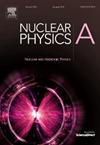Research on superheavy elements: Experimental prospects
IF 2.5
4区 物理与天体物理
Q2 PHYSICS, NUCLEAR
引用次数: 0
Abstract
What are the heaviest elements that can exist in Nature or be created on Earth? Does an ‘Island of Stability’ exist beyond uranium? Questions like these are often asked in connection with Long Range Plans of nuclear physics communities or large-scale accelerator facilities. Information on the chemical and physical properties of superheavy elements () or nuclei is notoriously difficult to collect, mainly because of tiny production and thus observation rates. This in turn limits experimental constraints of nuclear structure theory in particular. A selection of ongoing efforts and future possibilities to improve the experimental situation are presented. Nuclear theory is asked to anchor model predictions on already existing nuclear structure data in the superheavy region.
超重元素的研究:实验展望
自然界中或地球上能创造的最重的元素是什么?铀之外是否存在“稳定之岛”?这样的问题经常被问到与核物理社区或大型加速器设施的长期计划有关。众所周知,关于超重元素(Z>103)或原子核的化学和物理性质的信息很难收集,主要是因为它们的产量很小,因此观测率也很低。这反过来又特别限制了核结构理论的实验约束。提出了一些正在进行的努力和未来改善实验情况的可能性。核理论被要求锚定模型预测已经存在的超重区核结构数据。
本文章由计算机程序翻译,如有差异,请以英文原文为准。
求助全文
约1分钟内获得全文
求助全文
来源期刊

Nuclear Physics A
物理-物理:核物理
CiteScore
3.60
自引率
7.10%
发文量
113
审稿时长
61 days
期刊介绍:
Nuclear Physics A focuses on the domain of nuclear and hadronic physics and includes the following subsections: Nuclear Structure and Dynamics; Intermediate and High Energy Heavy Ion Physics; Hadronic Physics; Electromagnetic and Weak Interactions; Nuclear Astrophysics. The emphasis is on original research papers. A number of carefully selected and reviewed conference proceedings are published as an integral part of the journal.
 求助内容:
求助内容: 应助结果提醒方式:
应助结果提醒方式:


